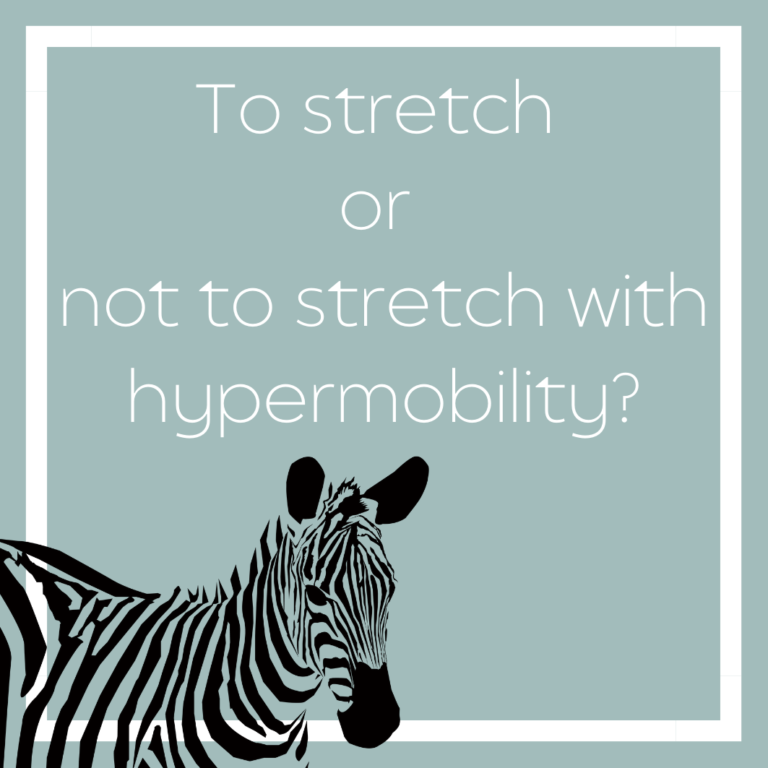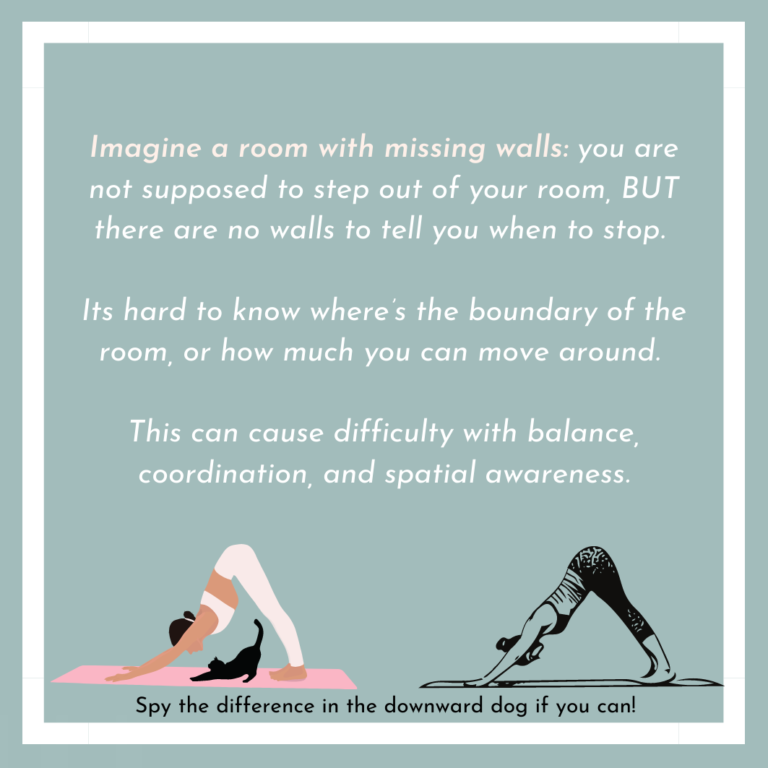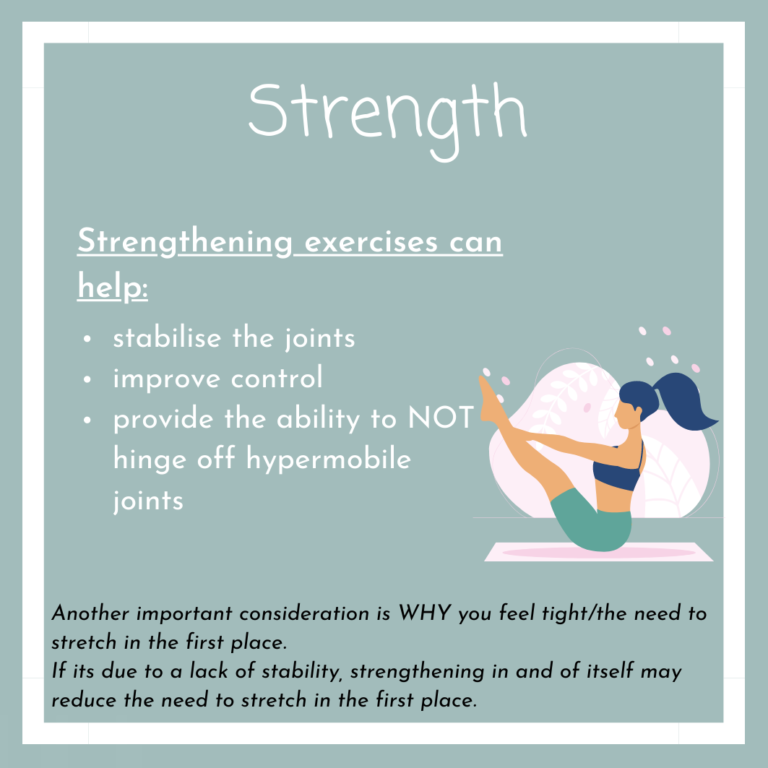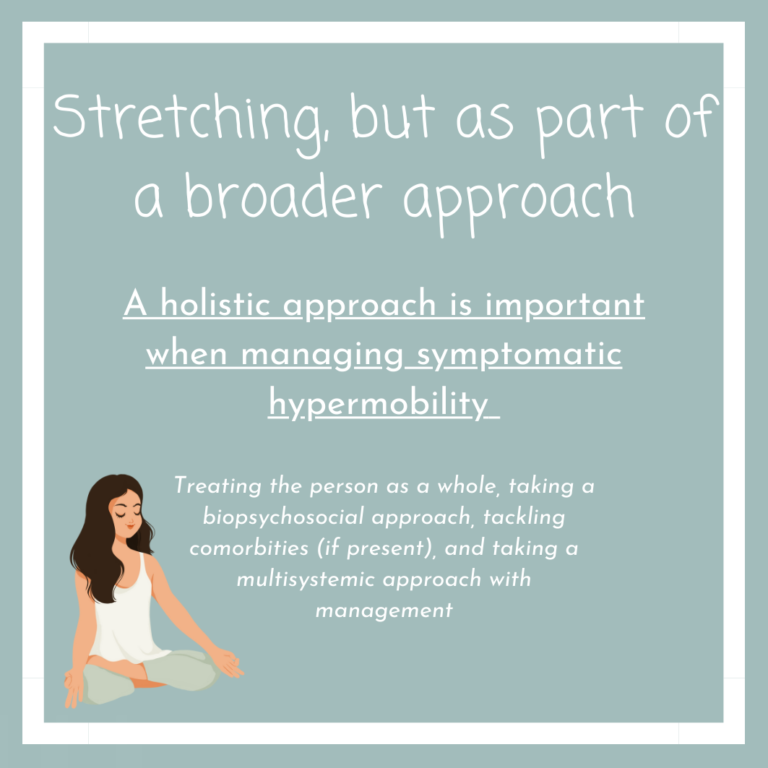







To stretch, or not to stretch with hypermobility:
People who have symptomatic joint hypermobility can experience joint pain and instability, which can greatly affect their quality of life. Coping with symptomatic hypermobility can be difficult, particularly when managing joint pain and instability. However, stretching can sometimes be a useful tool for hypermobile individuals in reducing pain and improving function, but only if used carefully and as part of a broader approach.
Hinging off hypermobility (impaired proprioception):
One of the primary concerns for stretching with hypermobility is the potential for individuals to “sink” into their joint end ranges. This is often described by individuals as “sinking into their joints”, or “hinging off their joints” without the appropriate muscular engagement to support the joints. For people with symptomatic joint hypermobility, this is a common occurrence due to the nature of their joints having greater than normal range of motion. In addition to this, hypermobile individuals tend to have impaired proprioception, which is the ability to sense the position and movement of the body. You can think of it as a room with missing walls: you are not supposed to step out of your room, but there are no walls to tell you when to stop. Its hard to know where’s the boundary of the room, or how much you can move around. This can cause difficulty with balance, coordination, and spatial awareness. Impaired proprioception can also result in an increased risk of injury (yes, I am alsoooo talking about perpatually walking into things, or tripping over your own two feet), as well as difficulty in performing precise movements. Therefore, hypermobile individuals may benefit from exercises that improve their proprioceptive awareness. When stretching, it is hence important to consider and address proprioceptive awareness where necessary, while guiding them away from hinging off their joints.
Strength:
Another important consideration when it comes to stretching for hypermobile individuals is to focus on strengthening exercises. Strengthening exercises can help stabilise the joints, improve control and reducing the risk of hinging off hypermobile joints. Additionally, strengthening exercises can help improve overall physical function and possibly reduce pain associated with symptomatic joint hypermobility. Strength training exercises should be designed based on an individual’s unique needs. Remember, no two zebras have the same stripes. The guidance of a qualified healthcare professional or exercise specialist experienced with hypermobility can be especially helpful to ensure that exercises are prescribed appropriately, and are performed safely and effectively.
Sensations:
It’s also important to pay close attention to the sensations that arise during stretching. While some discomfort can be normal during stretching, significant pain, discomfort or even excessive muscular “guarding” should all be cautioned against. While pain does not always equate to damage, it is important to respect how the nervous system feels too. If the nervous system feels threatened by the activity, it will naturally use pain as signal to get them to back off. If any of these sensations arise, it’s essential to stop the activity, and seek the advice of a healthcare professional or a trusted coach. If something doesn’t feel right, it probably isn’t. Always listen to your body, and believe yourself.
Stretching as part of a broader approach with hypermobility:
Lastly, it’s important to take a holistic approach to managing hypermobility, which includes adopting healthy lifestyle habits and engaging in physical activity that doesn’t exacerbate symptoms. This can include exercises like swimming, which allows for exercising without too much load the on joints, and can be useful for symptomatically hypermobile individuals who struggle with dysautonomia (eg. POTS, which is a common comorbidity in symptomatic hypermobility). Additionally, practicing relaxation techniques like meditation or breath work can help reduce pain and improve physical function, through stimulating the parasympathetic nervous system. Finally, it is important to treat the person as a whole, and take a multisystemic approach in managing hypermobility. Comorbidities (eg. gastrointestinal issues, endometriosis, dysautonomia etc.) if present, must concurrently be addressed too, in order to see improvement in overall wellbeing. The body works as a whole, and each stressor all has a part to play in feeding into an individual’s pain and physical discomfort experienced. Taking a multisystemic and biopsychosocial approach is hence key to managing hypermobility.
[Note: Of course, as a coach you can never be expected to take care of everything. Referring them out to appropriate medical professionals is important, and if possible, working alongside their medical care team can be extremely helpful in holistically helping such individuals.]
Final thoughts on stretching with hypermobility:
In conclusion, stretching can actually be a valuable tool for managing symptoms associated with hypermobility. However, it’s crucial to approach stretching with caution, adopt safe and appropriate techniques, and understand that stretching is merely a tool in a bigger toolkit. Stretching itself does not solve any underlying issue, BUT it can help relief symptoms. Improving proprioception, doing strengthening exercises, paying attention to sensations, and taking a holistic approach to managing hypermobility will all be important in contributing to improved physical function and reduced pain for individuals with symptomatic joint hypermobility in the longer term.
[Note: by stretching, I do NOT mean contortion & advanced flexibility training. I actually just mean normal human level stretching haha! Contortion & advanced flexibility training are an intentional choice for those who WANT to train it, be it for their sport or hobby. Contortion in and of itself is a athletic “sport”(and beautiful art form), with lots of strength, technique and discipline involved.]

